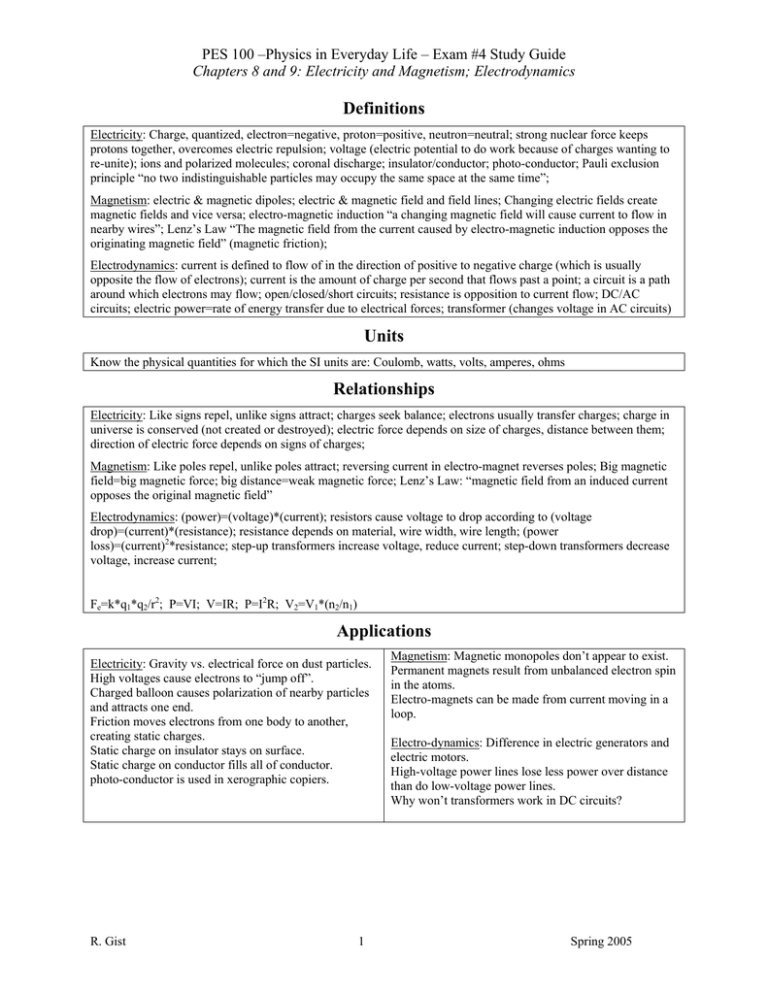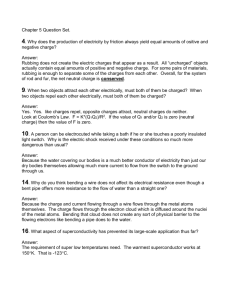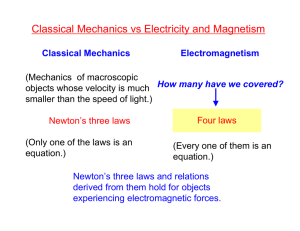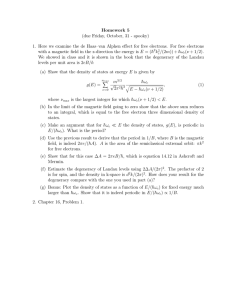Definitions PES 100 –Physics in Everyday Life – Exam #4 Study... Chapters 8 and 9: Electricity and Magnetism; Electrodynamics
advertisement

PES 100 –Physics in Everyday Life – Exam #4 Study Guide Chapters 8 and 9: Electricity and Magnetism; Electrodynamics Definitions Electricity: Charge, quantized, electron=negative, proton=positive, neutron=neutral; strong nuclear force keeps protons together, overcomes electric repulsion; voltage (electric potential to do work because of charges wanting to re-unite); ions and polarized molecules; coronal discharge; insulator/conductor; photo-conductor; Pauli exclusion principle “no two indistinguishable particles may occupy the same space at the same time”; Magnetism: electric & magnetic dipoles; electric & magnetic field and field lines; Changing electric fields create magnetic fields and vice versa; electro-magnetic induction “a changing magnetic field will cause current to flow in nearby wires”; Lenz’s Law “The magnetic field from the current caused by electro-magnetic induction opposes the originating magnetic field” (magnetic friction); Electrodynamics: current is defined to flow of in the direction of positive to negative charge (which is usually opposite the flow of electrons); current is the amount of charge per second that flows past a point; a circuit is a path around which electrons may flow; open/closed/short circuits; resistance is opposition to current flow; DC/AC circuits; electric power=rate of energy transfer due to electrical forces; transformer (changes voltage in AC circuits) Units Know the physical quantities for which the SI units are: Coulomb, watts, volts, amperes, ohms Relationships Electricity: Like signs repel, unlike signs attract; charges seek balance; electrons usually transfer charges; charge in universe is conserved (not created or destroyed); electric force depends on size of charges, distance between them; direction of electric force depends on signs of charges; Magnetism: Like poles repel, unlike poles attract; reversing current in electro-magnet reverses poles; Big magnetic field=big magnetic force; big distance=weak magnetic force; Lenz’s Law: “magnetic field from an induced current opposes the original magnetic field” Electrodynamics: (power)=(voltage)*(current); resistors cause voltage to drop according to (voltage drop)=(current)*(resistance); resistance depends on material, wire width, wire length; (power loss)=(current)2*resistance; step-up transformers increase voltage, reduce current; step-down transformers decrease voltage, increase current; Fe=k*q1*q2/r2; P=VI; V=IR; P=I2R; V2=V1*(n2/n1) Applications Electricity: Gravity vs. electrical force on dust particles. High voltages cause electrons to “jump off”. Charged balloon causes polarization of nearby particles and attracts one end. Friction moves electrons from one body to another, creating static charges. Static charge on insulator stays on surface. Static charge on conductor fills all of conductor. photo-conductor is used in xerographic copiers. R. Gist 1 Magnetism: Magnetic monopoles don’t appear to exist. Permanent magnets result from unbalanced electron spin in the atoms. Electro-magnets can be made from current moving in a loop. Electro-dynamics: Difference in electric generators and electric motors. High-voltage power lines lose less power over distance than do low-voltage power lines. Why won’t transformers work in DC circuits? Spring 2005





